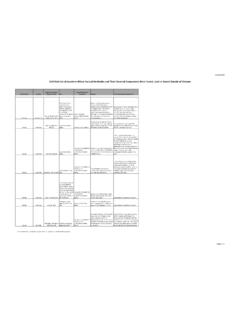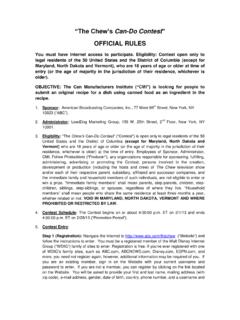Transcription of Smokeless Tobacco: A Veteran's Guide for Quitting
1 Smokeless To b a c c oA Veteran s Guide for QuittingA Resource for VeteransTable of ContentsCHAPTER 1: Introduction .. 1 CHAPTER 2: Smokeless tobacco and Addiction .. 2 CHAPTER 3: Your Reasons for Quitting .. 4 CHAPTER 4: Preparing to Quit .. 8 CHAPTER 5: Using tobacco Cessation Medications ..12 CHAPTER 6: Your First Two Weeks After Quitting : Coping With Withdrawal Symptoms & Triggers ..19 CHAPTER 7: Celebrate Your Success and Stay Quit for Good! ..23 AcknowledgementsSmokeless tobacco : A Veteran s Guide for Quitting was developed as a tobacco cessation resource for veterans who use Smokeless tobacco . Its primary purpose is to promote tobacco cessation interventions, based on published principles of evidence- and consensus-based clinical practice, for use by Department of veterans Affairs (VA) health care providers treating veterans who use Smokeless tobacco . This Guide was adapted from the National Institutes of Health resource Smokeless tobacco : A Guide for Quitting , created in 2012.
2 Many thanks to Dr. Kim Hamlett-Berry, Director of tobacco & Health: Policy and Programs in Mental Health Services, veterans Health Administration Office of Patient Care Services, for supporting this project; Dr. Tim Chen, Dr. Dana Christofferson, and Dr. Clint McSherry for their literature review, content contributions, and editing; Dr. Bradley Benedict, Dr. Bruce Capehart, Dr. Julianne Himstreet, Dr. Cathy Williams-Sledge, and Bridgette Vest for their thoughtful review and comments; and Leah Stockett for organizing and editing the Department of veterans AffairsVeterans Health AdministrationWashington, DC 20420 Smokeless tobacco : A Veteran's Guide for Quitting February 20171 CHAPTER 1: IntroductionCHAPTER 1: IntroductionSO YOU USE chew OR DIP, AND YOU'D LIKE TO ! You re taking the first step to Quitting tobacco . Perhaps you ve learned about the health risks of Smokeless tobacco , or your doctor or dentist suggested it would be good for you to quit.
3 Maybe this is your first time trying to quit dip or chew , or maybe you've tried before and found that Quitting is not easy. Quitting tobacco , any kind of tobacco , is a challenge. You can do it, and the Department of veterans Affairs (VA) is here to help! This Guide can help you make your own quit plan so you can quit for Guide includes recent research on the most effective ways to quit Smokeless tobacco . Like most people who dip or chew , you may already know there are many reasons to quit. Whether it is to improve your health, save money, or another reason, it is important to find your personal reasons for Quitting , and use those reasons to motivate 2: Smokeless tobacco and AddictionCHAPTER 2: Smokeless tobacco and AddictionSmokeless tobacco contains 2,000 chemical compounds, including 30 cancer-causing chemicals such as: arsenic nickel uranium cadmium lead formaldehyde tobacco -specific nitrosaminesTobacco-specific nitrosamines (TSNA) are by far the most harmful.
4 TSNA levels in Smokeless tobacco can be as much as 100X higher than other tobacco tobacco includes dip, chew , moist snuff, and snus. All tobacco products, including Smokeless tobacco , contain nicotine. Nicotine is the addictive part of tobacco and causes the pleasurable feelings some people get, but nicotine is not by itself harmful to your body. Dip and chewing tobacco actually contain more nicotine than cigarettes, which may cause an even stronger addiction. Smokeless tobacco users experience nicotine addiction differently from people who smoke cigarettes. With cigarettes, nicotine is delivered into the blood very quickly; but the nicotine level rapidly declines, causing withdrawal for the smoker and the urge to smoke another cigarette. Dipping or chewing tobacco results in a slower and steadier rise in the blood nicotine level, which remains higher for a longer period of time than when smoking in mind: Holding an average-size dip in your mouth for 30 minutes gives you as much nicotine as chain-smoking three cigarettes.
5 A 2-can-a-week dipper gets as much nicotine as a 1- to 1 -pack-a-day is a list comparing the nicotine levels of some selected Smokeless tobacco brands:Nicotine levels of selected brands, from highest to lowest1. Grizzly Fine Cut Regular2. Skoal Long Cut Regular3. Copenhagen Long Cut4. Kodiak Wintergreen5. Skoal Bandits Mint6. Hawken Wintergreen* This list is provided for information only. VA does not endorse the use of any tobacco product. The level of nicotine you get from dipping or chewing depends on the specific product you use, as well as the amount you use, how long you use it, and how often you dip or 2: Smokeless tobacco and AddictionHOW ADDICTED ARE YOU?Think about your Smokeless tobacco habit. Answer the questions below, and add up your total score. This will give you an idea of how physically addicted you are to the nicotine in Smokeless How soon after you wake up do you place your first dip?Within 5 minutes: _____ 3 points6 30 minutes: _____ 2 points31 60 minutes: _____ 1 pointAfter 60 minutes: _____ 0 points2.
6 How often do you intentionally swallow tobacco juice?Always: _____ 2 pointsSometimes: _____ 1 pointNever: _____ 0 points3. Which chew would you hate to give up most? The first one in the morning: _____ 1 pointAny other: _____ 0 points4. How many cans/pouches per week do you use?More than 3: _____ 2 points2 3: _____ 1 point1: _____ 0 points5. Do you chew more frequently during the first hours after awakening than during the rest of the day?Yes: _____ 1 pointNo: _____ 0 points6. Do you chew if you are so ill that you are in bed most of the day?Yes: _____ 1 pointNo: _____ 0 pointsTOTAL: _____ pointsScoring: High dependence (8+ points)Moderate dependence (5 7 points) Low-to-moderate dependence (3 4 points)Low dependence (1 2 points)4 CHAPTER 3: Your Reasons for QuittingThere are multiple myths about Smokeless tobacco , and sometimes these myths make users feel more comfortable in their : Smokeless tobacco is a harmless alternative to : Smokeless tobacco is still tobacco .
7 Smokeless tobacco often contains higher levels of cancer-causing chemicals called nitrosamines. Note the health warning on Smokeless tobacco :Good tooth and gum care can offset the harmful effects of using dip or uth: There is no evidence that brushing and flossing will undo the harm that dip and chew are doing to your teeth and gums. tobacco contains chemicals like nitrosamines that cause oral :It's easy to quit using dip or chew when you want : Unfortunately, nicotine addiction makes Quitting difficult. But those who have successfully quit are very glad they :Dip (or chew ) improves athletic :A study of professional baseball players found no connection between Smokeless tobacco use and player performance. Using Smokeless tobacco increases your heart rate and blood pressure within minutes. This can cause a buzz or rush, but the rise in pulse and blood pressure places extra stress on your heart. Several Major League Baseball players are strong supporters of Quitting chew or snuff.
8 In fact, many sports facilities have also banned Smokeless tobacco THE DIP OR chew HABIT CAN BE TOUGH; BUT IT CAN BE DONE, AND YOU CAN DO IT. The best approach to Quitting tobacco is to understand your reasons for wanting to quit, pick a quit date, and come up with a quit plan. Your VA health care provider can help you develop a quit plan that may include medications, counseling, groups, or phone contacts. It s up to you how you quit, and VA offers you a choice of many different kinds of support. Know your reasons for Quitting , and don't let outside influences like peer pressure get in your way. Remember to focus on everything you don't like about dipping and 3: Your Reasons for Quitting5 HEALTH EFFECTS OF DIPPING AND CHEWINGFor many people, their main reason for Quitting is to prevent the negative health problems that Smokeless tobacco can cause. Smokeless tobacco causes cancer of the mouth, esophagus, and pancreas. Smokeless tobacco may increase your risk of death from heart disease and stroke.
9 Dippers/chewers have more dental problems than nonusers. Sugar in Smokeless tobacco can cause cavities, chronic painful sores, and decay in exposed tooth roots. Dip and chew can cause your gums to pull away (recede) from the teeth in the area where the tobacco is held, causing your teeth to become loose. Unfortunately, your gums will not grow back to where they were before, which can cause tooth loss. Dippers and chewers commonly get leathery white patches and red sores in their mouths that can turn into cancer. See your doctor right away for any early signs of oral cancer such as: a sore in your mouth that bleeds easily and does not heal a lump in your mouth or neck soreness or swelling that does not go away a white patch that does not go away trouble chewing, swallowing, or moving your tongue or jawCHAPTER 3: Your Reasons for Quitting6 NEED MORE REASONS TO QUIT? It s expensive!With each can of dip costing an average of $4, a 2-can-a-week habit costs $416 a year while a 1-can-a-day habit costs $1,460 a year!
10 Likewise, chewing tobacco costs about $3 a pouch, so a 1-pouch-a-day habit costs more than $1,000 a year. The cost adds up. Think about all the things you could do with that money instead!ExampleMy ExperienceIf you use 2 cans per weekI use _____ cans or pouches per week1 can costs $41 can or pouch costs $_____2 cans/week x $4 each = $8 per week_____ cans or pouches/week x $_____ each = $_____ per week$8/week x 52 weeks a year = $416 spent each year$_____ per week x 52 weeks a year = $_____ spent each year It s not attractiveChewing tobacco will stain your teeth and give you bad breath. While you may become used to the odor, the smell of Smokeless tobacco is not pleasant to others around you. Look at your teeth. Are they stained from tobacco juice? Brushing your teeth won t make this go away. tobacco juice Finding a place to spit tobacco juice isn t always easy. Even when you have a cup, other people may not like seeing it, and it can spill.



















